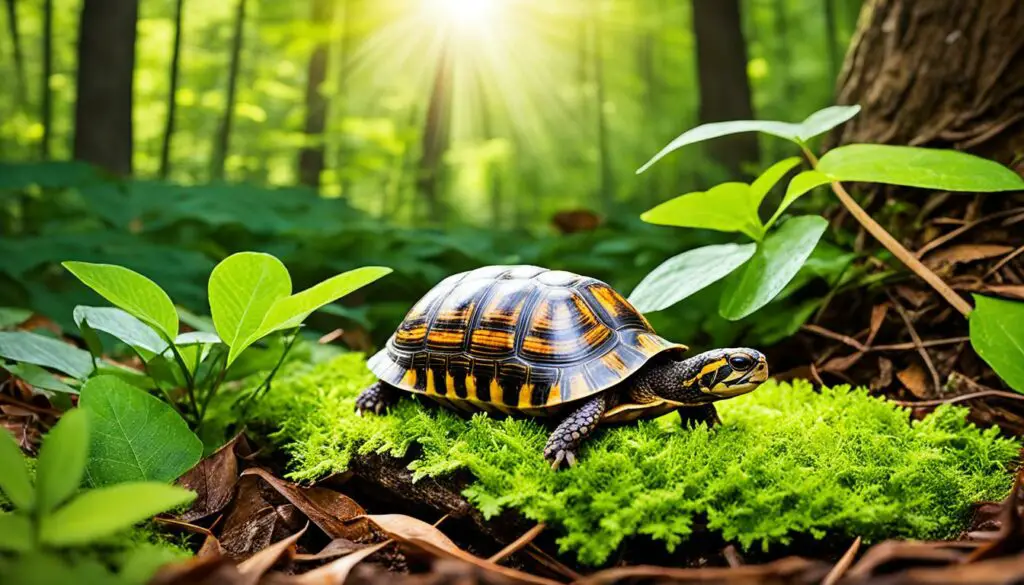Ever wondered about the ideal home for a box turtle? These fascinating reptiles need certain conditions to thrive. They need loose soil for burrowing and water nearby for drinking and soaking.
Many think box turtles only live on land. But they need various food options like invertebrates, fruits, and vegetation. This means their home should be full of food to keep them healthy and strong.
Also, the perfect box turtle home supports their special abilities. For instance, their hinged plastron keeps them safe, and their digging feet help them burrow in the winter. Want to know more about their ideal habitat? Keep reading to discover what makes the best box turtle home.
The Natural Environment of Box Turtles
Box turtles love places with lots of resources to survive. Knowing what they need helps protect their homes. Conservation efforts then become more effective.
Forest Habitats
Box turtles often live in the woods. They hide under leaves and use downed branches for cover. The forest ground provides food and protection, making it perfect for them. These spots are vital for their survival.
Moist and Shaded Areas
Moist, shady places are box turtles’ favorites. They find safety from enemies and stay cool in the shade. The dampness in these spots keeps them hydrated and comfortable. This makes such areas crucial for their well-being.
Access to Water
Box turtles must have water sources nearby. They need it to drink and to cool down. Having water close means they can be healthy and carry out their habits.
Characteristics of Ideal Box Turtle Habitat
Building the perfect place for box turtles is key for their health. They need certain features to thrive. This includes spots to bask and different kinds of shelters.
Basking Spots
Box turtles need outside warmth to stay healthy. Basking spots are vital for them to get this heat. Things like rocks, logs, and sunny areas help them warm up. This also boosts their digestion and energy.
Shelter Options
Shelter is crucial for box turtles’ safety. It helps them stay away from predators and bad weather. They can use underground spots, thick plants, and piles of leaves or logs. These places are especially important in cold times. They help turtles keep warm.
Eastern Box Turtle Habitat Preferences
Eastern box turtles like various habitats and do well in different places. They look for areas with a lot of food and places to hide. Places with a lot of trees and plants are their favorite spots.
Geographical Distribution
Eastern box turtles are spread widely in places like Alabama. This broad distribution helps them live in many different ecosystems. They find what they need in areas with lots of different plants and safe places to hide.
Preferred Vegetation
Plants are key for eastern box turtles’ homes. They love areas full of trees and plants like mushrooms, berries, and dandelions. These places give them food and keep them safe.
Box turtles in Alabama, like the three-toed and Gulf Coast types, like the same places. But, there are small differences to meet their special needs. This helps each kind of turtle to do their best in their own home.
| Box Turtle Type | Preferred Habitat Region | Key Vegetation |
|---|---|---|
| Eastern Box Turtle | Forests of Alabama and surrounding areas | Mushrooms, berries, dandelions |
| Three-Toed Box Turtle | Moist, grassy woodlands | Insects, fruits, foliage |
| Gulf Coast Box Turtle | Coastal plains with dense underbrush | Marine plants, grasses, small invertebrates |
Seasonal Variations in Box Turtle Habitats
Box turtles change where they live based on the season. They do this to survive and find the best conditions to live in, all year. The seasons cause a lot of the changes, bringing different temperatures and environments.
Summer Habitats
In summer, these turtles prefer cooler, shady spots. Places with a lot of plants help them hide from the sun. They might also dig into the ground or under leaves to keep cool and keep from drying out. They always need to be near water so they can soak when they get too hot.
Winter Habitats
Winter makes the turtles find new homes. The colder it gets, the deeper they dig their burrows, which can be up to two feet deep. These deeper spots keep them warm, protect them from other animals, and are perfect for hibernating. This special winter home is key to surviving the coldest times, forest fires, and other dangers.
| Season | Habitat Characteristics | Adaptive Features |
|---|---|---|
| Summer | Cool, shaded areas; dense vegetation; proximity to water | Burrowing under leaves or soil; frequent soaking |
| Winter | Deep burrows up to two feet; insulated from extreme cold | Hibernating to avoid predators and harsh conditions |
Learning about how box turtles’ needs change with the seasons is important. It helps us know how to make the perfect homes for them. Setting up their spaces just right ensures their well-being, whether they live in the wild or with us.
What Types of Habitats Do Box Turtles Prefer?
Box turtles love living in a mix of places, especially near water. These spots provide what they need like food, water, and safety. They find places with lots of leaves and fallen branches great because they can hide and look for food.
An ideal box turtle habitat has plenty of food like bugs, fruits, and plants. These places let the turtles eat well. They also need hiding spots like bushes, logs, and rocks. These keep them safe from dangers like other animals and bad weather.
Box turtles change where they live depending on the season. They like cool, shady places in the summer. In winter, they make deep holes to sleep in. This helps them stay healthy throughout the year.
To wrap up, box turtles like homes with land and water, lots of leaves for hiding and food, and many hiding spots and food types. This helps them do well in every season.
Role of Leaf Litter and Ground Cover
Leaf litter and ground cover are key for box turtle living conditions. They help turtles survive and reproduce successfully. These parts of the environment are crucial.
Food Sources
Leaf litter provides lots of food for box turtles. It has insects, worms, and more that they eat. Plus, mushrooms and berries grow in this damp, decaying layer, adding to the food variety.

Camouflage and Protection
Ground cover hides box turtles and keeps them safe. It lets them look like their surroundings, hiding from danger. This cover is also important for egg-laying. Females need safe, sandy spots in their box turtle living conditions to lay eggs without worry.
| Component | Role |
|---|---|
| Leaf Litter | Hosts food sources like invertebrates and fosters growth of mushrooms and berries. |
| Ground Cover | Provides camouflage, predator evasion, and secure egg-laying environments. |
The Importance of Water Sources for Box Turtles
Water is critical for the box turtle environment. It’s essential for their hydration and survival. Box turtles eat fruits and plants that are full of water. But, having access to standing water is even more important.
Standing water is more than just a place to drink. It’s also where turtles soak. Soaking is key for their health, helping them keep the right body temperature. It also helps them shed their old skin and get rid of parasites.
- Hydration
- Thermoregulation
- Skin shedding
- Parasite removal
Turtles live on land, but they still need to be close to water. This way, they can easily get the benefits they need. This is especially important in hot weather. During these times, they might not get enough water from their food.
Artificial Habitats for Box Turtles
Building the perfect home for box turtles is all about imitating their natural world. You need to include things like their food, water, and spaces to explore. This helps them feel at home, whether in your backyard or in outdoor pens. This guide will show you how to make the best living space for them.
Creating a Backyard Habitat
For a great backyard space, make sure you have everything a box turtle needs. Here’s what to include:
- Food Sources: Add natural food like berries and bugs for them to eat.
- Water Access: Put in shallow water for drinking and soaking.
- Shelter: Include hiding spots to keep them safe and help with warmth.
- Sun and Shade: Have sunny spots for warming up and shady areas to cool off.
Maintaining Outdoor Enclosures
Keeping up outdoor homes for box turtles is key for their health and happiness. Follow these steps to keep them thriving:
- Regular Maintenance: Clean their water and food areas often. Also, get rid of bugs and keep the food fresh.
- Habitat Diversity: Mix up the ground with sandy spots and lots of plants. This gives them places to hide and explore.
- Security: Make sure their area is safe from other animals and that turtles can’t get out. Good fences are very important.
- Microclimates: Create different temperatures and dampness levels throughout. This helps turtles stay comfortable and healthy.
With a little planning and work, you can make a great place for box turtles. A spot where they can act natural, feel good, and stay safe.
Threats to Box Turtle Habitats
Box turtle habitats face big threats, mainly from losing land to cities. As towns grow, they take away the natural places box turtles need. These places are where they find food, shelter, and raise their young. Losing this space makes it hard for turtles to live and find what they need, which puts them at risk.
Another danger for box turtles is other animals that eat them, like raccoons and pets. With more people around, these encounters increase. So does the danger from cars. Many turtles die trying to cross roads in search of better places to live or food.
People doing certain activities can also hurt box turtle homes. Things like cutting down trees and farming can destroy where these turtles live. We need to protect their homes to help them survive. By stoping threats like these, we protect these important homes, helping box turtles and the nature around them thrive.
FAQ
What types of habitats do box turtles prefer?
Box turtles like areas with food, water, and shelter nearby. They enjoy forests with lots of hiding places like leaf litter and branches. These places are cool, moist, and not far from water.
What is the natural environment of box turtles like?
Box turtles live in forests full of leaf litter. They find their food and hide there. They need cool, wet spots and water to drink and soak in.
Are there specific features that make a habitat ideal for box turtles?
Ideal homes for box turtles have sunny spots to warm up and many places to hide. This includes burrows, plants, logs, and rocks. These spots keep them safe from harm.
What are the habitat preferences of Eastern box turtles?
In places like Alabama, Eastern box turtles enjoy dense forests. These areas have lots of mushrooms, berries, and dandelions. They eat these plants and use them for hiding.
How do box turtles adapt their habitats with the changing seasons?
In summer, they move to cool, shaded areas to avoid heat. They burrow under leaves or soil. In winter, they hibernate in deep burrows to stay warm and safe.
Why is leaf litter important in box turtle habitats?
Leaf litter is key for box turtles. It provides food when it breaks down, like mushrooms and berries. It also hides them from danger and lets them safely lay their eggs.
How important are water sources for box turtles?
Water is essential for box turtles. It keeps them hydrated and lets them soak. And though they get water from plants, ponds help meet their needs and keep them healthy.
How can I create an artificial habitat for box turtles?
To make a backyard safe for box turtles, you need food, water, and shelter. Include both sunny and shady areas. Add places for hiding to make it feel like their natural home.
What threats do box turtle habitats face?
Box turtle homes are in danger from losing land to cities and roads. They also face dangers from animals and how we manage their environment. Protecting their homes is critical to keeping them safe and well.







